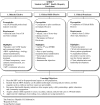A model for interprofessional health disparities education: student-led curriculum on chronic hepatitis B infection
- PMID: 20352509
- PMCID: PMC2847097
- DOI: 10.1007/s11606-009-1234-z
A model for interprofessional health disparities education: student-led curriculum on chronic hepatitis B infection
Abstract
Background: Although health disparities are commonly addressed in preclinical didactic curricula, direct patient care activities with affected communities are more limited.
Purpose: To address this problem, health professional students designed a preclinical service-learning curriculum on hepatitis B viral (HBV) infection, a major health disparity affecting the Asian/Pacific Islander (API) population, integrating lectures, skills training, and direct patient care at student-run clinics.
Setting: An urban health professions campus.
Methods: Medical and other health professional students at University of California, San Francisco, organized a preclinical didactic and experiential elective, and established two monthly clinics offering HBV screening, vaccination, and education to the community.
Results: Between 2004 and 2009, 477 students enrolled in the student-led HBV curriculum. Since the clinics' inception in 2007, 804 patients have been screened for chronic HBV; 87% were API immigrants, 63% had limited English proficiency, and 46% were uninsured. Serologically, 10% were found to be chronic HBV carriers, 44% were susceptible to HBV, and 46% were immune.
Discussion: Our student-led didactic and experiential elective can serve as an interprofessional curricular model for learning about specific health disparities while providing important services to the local community.
Figures
Similar articles
-
Learning through service: student perceptions on volunteering at interprofessional hepatitis B student-run clinics.J Cancer Educ. 2011 Jun;26(2):228-33. doi: 10.1007/s13187-010-0142-6. J Cancer Educ. 2011. PMID: 20652476 Free PMC article.
-
Hepatitis B ESL education for Asian immigrants.J Community Health. 2011 Feb;36(1):35-41. doi: 10.1007/s10900-010-9279-9. J Community Health. 2011. PMID: 20559696 Free PMC article. Clinical Trial.
-
Community health education at student-run clinics leads to sustained improvement in patients' hepatitis B knowledge.J Community Health. 2013 Jun;38(3):471-9. doi: 10.1007/s10900-012-9631-3. J Community Health. 2013. PMID: 23161212
-
Exploring the "led" in health professional student-led experiences: a scoping review.Adv Health Sci Educ Theory Pract. 2025 Jun;30(3):1007-1036. doi: 10.1007/s10459-024-10355-x. Epub 2024 Oct 24. Adv Health Sci Educ Theory Pract. 2025. PMID: 39446236 Free PMC article.
-
Student outcomes for interprofessional education in student led clinics: A rapid review.J Interprof Care. 2022 Mar-Apr;36(2):234-244. doi: 10.1080/13561820.2020.1858767. Epub 2021 Jan 12. J Interprof Care. 2022. PMID: 33435773 Review.
Cited by
-
Integrating health disparities content into health informatics courses: a cross-sectional survey study and recommendations.JAMIA Open. 2023 Mar 16;6(1):ooac101. doi: 10.1093/jamiaopen/ooac101. eCollection 2023 Apr. JAMIA Open. 2023. PMID: 36950472 Free PMC article.
-
Hepatitis B Virus Vaccination Coverage in Medical, Nursing, and Paramedical Students: A Cross-Sectional, Multi-Centered Study in Greece.Int J Environ Res Public Health. 2016 Mar 15;13(3):323. doi: 10.3390/ijerph13030323. Int J Environ Res Public Health. 2016. PMID: 26999171 Free PMC article.
-
Exploration and practice of humanistic education for medical students based on volunteerism.Med Educ Online. 2023 Dec;28(1):2182691. doi: 10.1080/10872981.2023.2182691. Med Educ Online. 2023. PMID: 36840966 Free PMC article. Review.
-
Learning through service: student perceptions on volunteering at interprofessional hepatitis B student-run clinics.J Cancer Educ. 2011 Jun;26(2):228-33. doi: 10.1007/s13187-010-0142-6. J Cancer Educ. 2011. PMID: 20652476 Free PMC article.
-
Using survey results regarding hepatitis B knowledge, community awareness and testing behavior among Asians to improve the San Francisco Hep B Free campaign.J Community Health. 2012 Apr;37(2):350-64. doi: 10.1007/s10900-011-9452-9. J Community Health. 2012. PMID: 21874365 Free PMC article.
References
-
- Unequal Treatment: Confronting Racial and Ethnic Disparities in Health Care. Washington, DC: National Academies Press; 2002. - PubMed
-
- Functions and Structure of a Medical School: Standards for Accreditation of Medical Education Programs Leading to the M.D. Degree. Updated June 2008. Available at www.lcme.org. Accessed December 14, 2009.
-
- Smith W, Betancourt JR, Wynia MK, et al. Recommendations for teaching about racial and ethnic disparities in health and health care. Ann Intern Med. 2007;147(9):654–665. - PubMed
Publication types
MeSH terms
LinkOut - more resources
Full Text Sources
Medical



